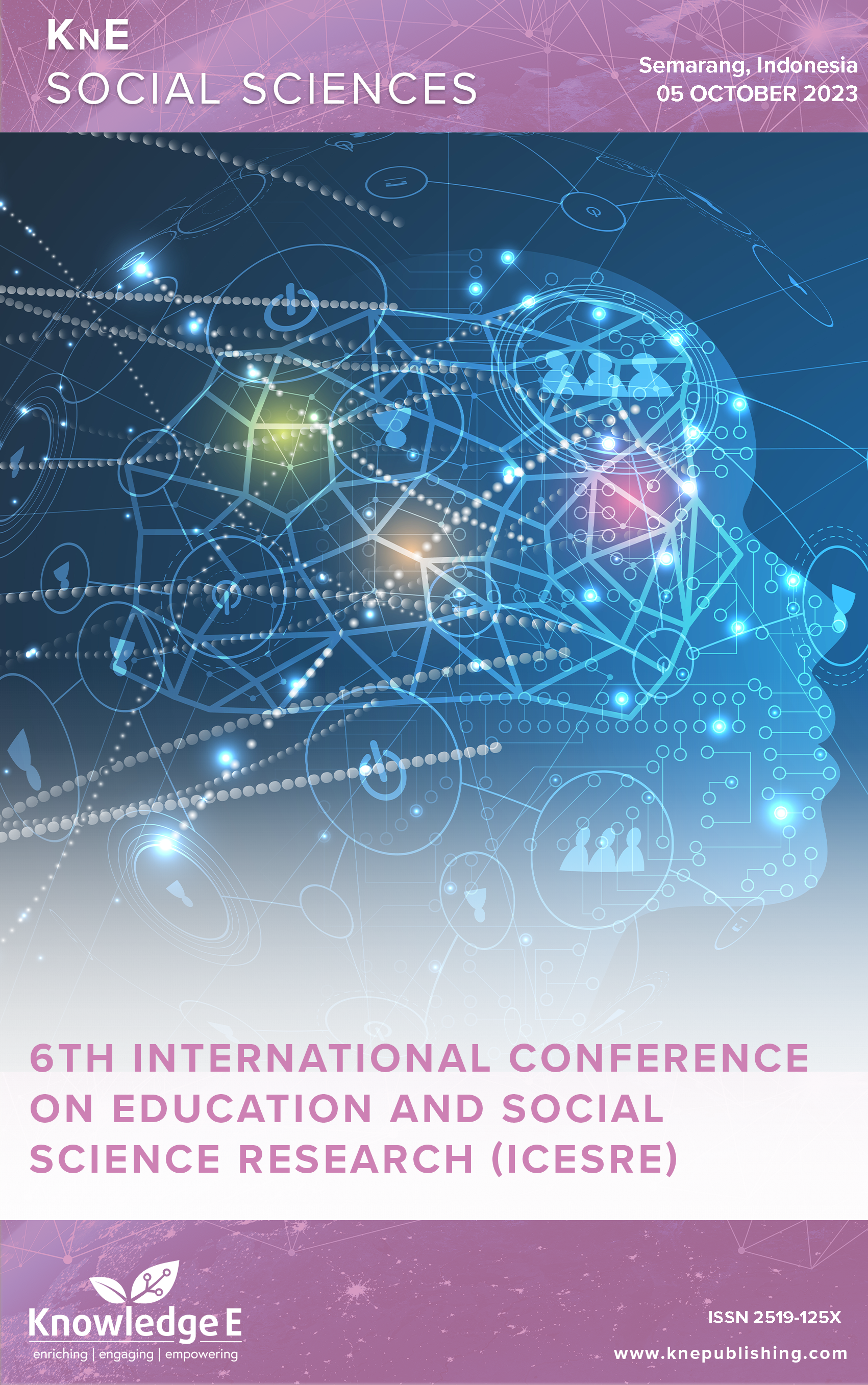Strategy for Preventing Potential Conflicts in the Establishment of Religious Minority Houses of Worship in the City of Semarang
DOI:
https://doi.org/10.18502/kss.v9i6.15277Abstract
Semarang City is a city that has social, religious, and cultural diversity. There is currently potential for conflict in several areas of Semarang City due to the rejection of the establishment of religious minority places of worship. The purpose of this research is to reveal the potential causes of conflicts over the construction of houses of worship of minority religions and to find appropriate strategies to prevent conflicts from occurring due to the construction of houses of worship of the majority religion. This qualitative research adopted a case study approach with data collection techniques of observation, documentation, and in-depth interviews with key informants and supporting informants. The results of this study indicate that in the Tlogosari and Sendangmulyo areas there is the potential for conflicts to occur against the background of the construction of a church house of worship, the root cause of this potential conflict is due to the refusal of permits. The conflict prevention strategy is to provide social education to the community regarding pluralism education with a social approach that is carried out with synergy between the government and the community. The implications of this research can be used as a reference by the Semarang City Government in preventing conflicts due to the establishment of religious minority places of worship.
Keywords: conflict prevention; conflict potential; social conflict; religious conflict
References
Baidhawy Z. Building harmony and peace through multiculturalist theology?based religious education: an alternative for contemporary Indonesia. Br J Relig Educ. 2007 Jan;29(1):15–30. DOI: https://doi.org/10.1080/01416200601037478
Asrawijaya E. Religious life in Indonesia in the Study of Post-Modernism. Khazanah Theologia. 2022 Apr;4(1):49–64. DOI: https://doi.org/10.15575/kt.v4i1.17871
Alam, M. (2016). Harmony in religious and cultural diversity, case study of Sungai Penuh city society. https://doi.org/10.24260/alalbab.v5i2.554. DOI: https://doi.org/10.24260/alalbab.v5i2.554
Budimansyah B. HS MA, Safari S. Religious Social Tolerance During the Time of the Prophet Muhammad SAW and Its Relevance in the Development of a Pluralistic Society in Indonesia. Analisis. Jurnal Studi Keislaman. 2023 Jun;23(1):113–36.
Yusuf I. Dialogue Between Islam and Buddhism through the Concepts Ummatan Wasa?an (The Middle Nation) and Majjhima-Patipada (The Middle Way). Islam Stud.2009;:367–94.
Basuki S. Interreligious Dialogue: From Coexistence To Proexistence (Understanding The Views of Mukti Ali and Hans Kung). UMRAN-International Journal of Islamic and Civilizational Studies. 2018 Oct;5(2-1):2–1. DOI: https://doi.org/10.11113/umran2018.5n2-1.310
Suwarno D, Mawardi K. Models of Religious Conflict Resolution in Multicultural Societies. International Journal of Social Science, Education [SINOMICS JOURNAL]. Communist Econ. 2023 Apr;2(1):145–52. DOI: https://doi.org/10.54443/sj.v2i1.121
Asmara T, Noho MD. Religion and cosmopolitan society: religious conflict settlement based on legal culture. Cosmopolitan Civil Societies: An Interdisciplinary Journal. 2022 Dec;14(3):46–60. DOI: https://doi.org/10.5130/ccs.v14.i3.8166
Sahal M, Musadad AA, Akhyar M. Tolerance in multicultural education: A theoretical concept. International Journal of Multicultural and Multireligious Understanding. 2018;5(4):115–22. DOI: https://doi.org/10.18415/ijmmu.v5i4.212
Foner N, Alba R. Immigrant religion in the US and Western Europe: bridge or barrier to inclusion? Int Migr Rev. 2008 Jun;42(2):360–92. DOI: https://doi.org/10.1111/j.1747-7379.2008.00128.x
Hoernig H. Worship in the suburbs: the development experience of recent immigrant religious communities.
Riwanto A, Achmad A, Wahyuni S, Suryaningsih S, Krisda Putri D. Access to places of worship for persons with disabilities in Indonesia: law and policy completion. Cogent Soc Sci. 2023 Dec;9(2):2243753. DOI: https://doi.org/10.1080/23311886.2023.2243753
Woodward SC. Woodward* SC. Faith and tourism: planning tourism in relation to places of worship. Tourism and Hospitality Planning & Development. 2004 Aug;1(2):173–86. DOI: https://doi.org/10.1080/1479053042000251089
Germain A, Gagnon JE. Minority places of worship and zoning dilemmas in montreéal. Plann Theory Pract. 2003 Jan;4(3):295–318. DOI: https://doi.org/10.1080/1464935032000118652
Habermas J. Notes on post?secular society. New Perspect Q. 2008 Sep;25(4):17–29. DOI: https://doi.org/10.1111/j.1540-5842.2008.01017.x
Sampson IT. Religious violence in Nigeria: causal diagnoses and strategic recommendations to the state and religious communities. African Journal on Conflict Resolution. 2012;12(1):103–34.
Skeie G. Plurality and pluralism in religious education. International handbook of the religious, moral and spiritual dimensions in education. 2006:307-19. DOI: https://doi.org/10.1007/1-4020-5246-4_22
Arifianto YA, Triposa R, Saptorini S. Christian perspective on the tolerance of Christian religious education teachers and students in the era of disruption [ Jurnal Teologi Dan Pendidikan Agama Kristen]. KURIOS. 2021 Nov;7(2):381–91. DOI: https://doi.org/10.30995/kur.v7i2.295
Lan TJ. Heterogeneity, politics of ethnicity, and multiculturalism What is a viable framework for Indonesia? Wacana. 2011 Oct;13(2):279–92.20] DOI: https://doi.org/10.17510/wjhi.v13i2.24
Kymlicka W, Norman W. Citizenship in culturally diverse societies: Issues, contexts, concepts. Citizenship in diverse societies. 2000 Mar 16;1:1-43. DOI: https://doi.org/10.1093/019829770X.003.0001
Kirmayer LJ. The politics of diversity: Pluralism, multiculturalism and mental health. Transcult Psychiatry. 2019 Dec;56(6):1119–38. DOI: https://doi.org/10.1177/1363461519888608
Haryono H, Suneki S, Yunus M. Implementation of Religious Pluralism Tolerance in the Village of Penyangkringan, Kendal Regency [ Jurnal Etika Demokrasi]. JED. 2023 Feb;8(1):56–63.
Faist T. Transnationalization in international migration: implications for the study of citizenship and culture. Ethn Racial Stud. 2000 Jan;23(2):189–222. DOI: https://doi.org/10.1080/014198700329024
Kamali MH. Diversity and pluralism: A Qur’anic perspective. ICR Journal. 2009;1(1). DOI: https://doi.org/10.52282/icr.v1i1.12
Hiebert D, Ley D. Assimilation, cultural pluralism, and social exclusion among ethnocultural groups in Vancouver. Urban Geogr. 2003 Feb;24(1):16–44. DOI: https://doi.org/10.2747/0272-3638.24.1.16
Parekh B. Rethinking multiculturalism: cultural diversity and political theory. Ethnicities. 2001 Mar;1(1):109–15. DOI: https://doi.org/10.1177/146879680100100112
Rudmin FW. Critical history of the acculturation psychology of assimilation, separation, integration, and marginalization. Rev Gen Psychol. 2003 Mar;7(1):3–7. DOI: https://doi.org/10.1037//1089-2680.7.1.3
Van Oudenhoven JP, Ward C. Fading majority cultures: the implications of transnationalism and demographic changes for immigrant acculturation. J Community Appl Soc Psychol. 2013 Mar;23(2):81–97. DOI: https://doi.org/10.1002/casp.2132
Schachner MK, Noack P, Van de Vijver FJ, Eckstein K. Cultural diversity climate and psychological adjustment at school—equality and inclusion versus cultural pluralism. Child Dev. 2016 Jul;87(4):1175–91. DOI: https://doi.org/10.1111/cdev.12536
Berry JW. Globalisation and acculturation. Int J Intercult Relat. 2008 Jul;32(4):328– 36. DOI: https://doi.org/10.1016/j.ijintrel.2008.04.001
Rahman MT, Setia P. Pluralism in the Light of Islam. Jurnal Iman Dan Spiritualitas. 2021;1(2):204–10. DOI: https://doi.org/10.15575/jis.v1i2.12269
Hakim D. Inclusivism and exclusivism as well as their effect on islamic education based multicultural. International Journal of Islamic Education [IJIERM]. Research and Multiculturalism. 2019 Nov;1(1):18–29. DOI: https://doi.org/10.47006/ijierm.v1i1.3
Jahanbegloo R. Is a Muslim Gandhi possible? Integrating cultural and religious plurality in Islamic traditions. Philos Soc Criticism. 2010 Mar;36(3-4):309–23. DOI: https://doi.org/10.1177/0191453709358839

